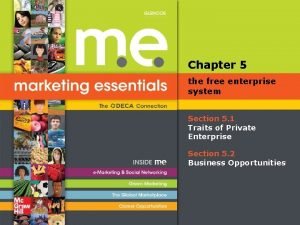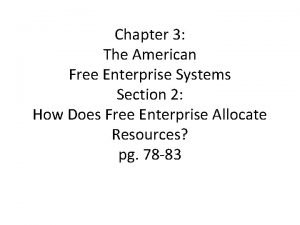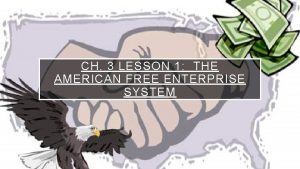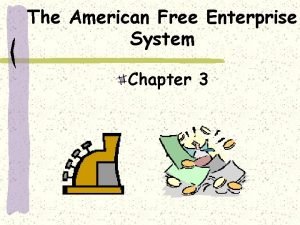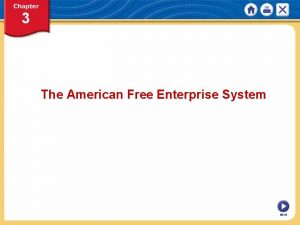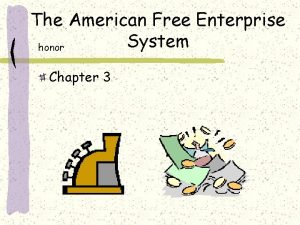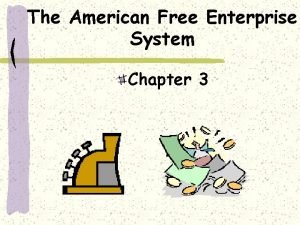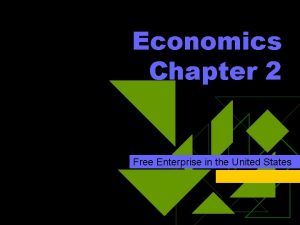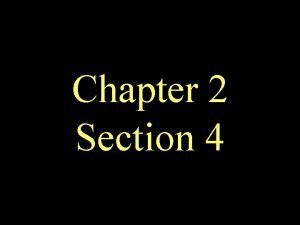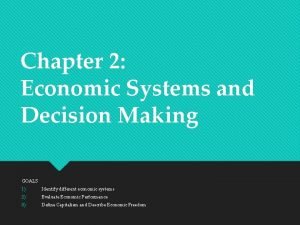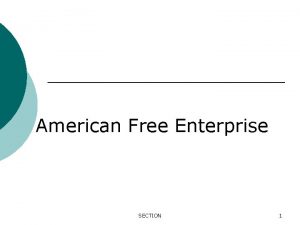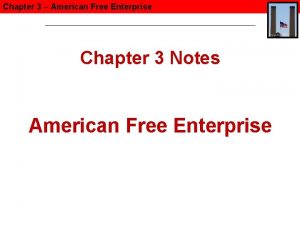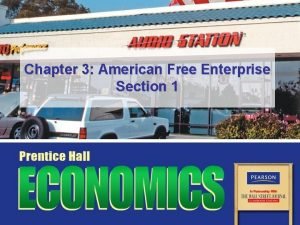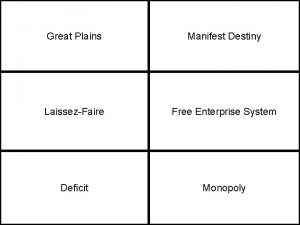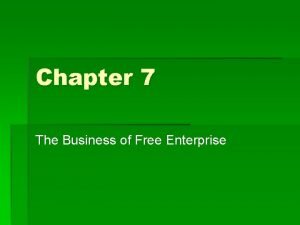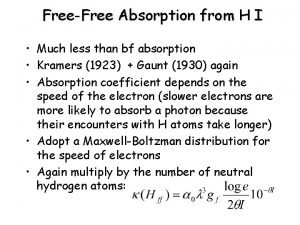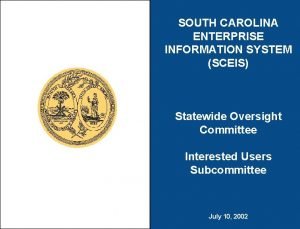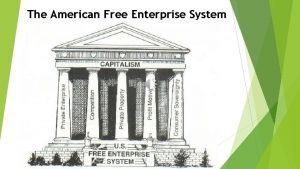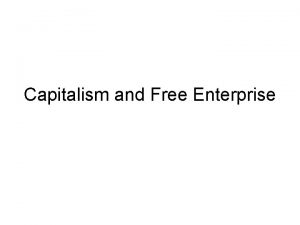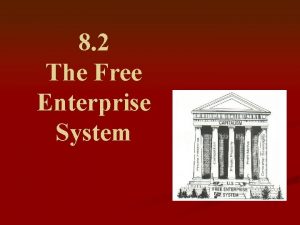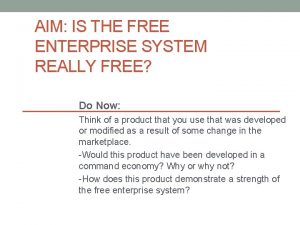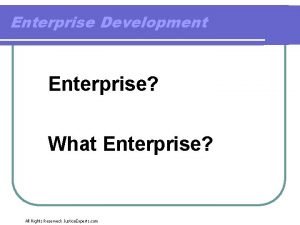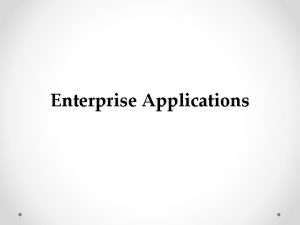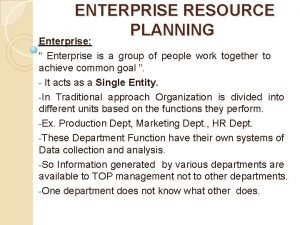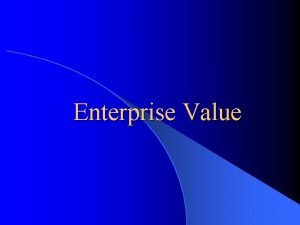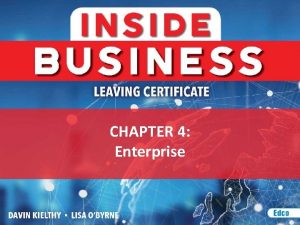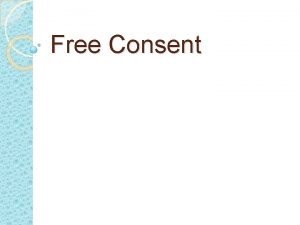Free Enterprise System Free Enterprise System n In






























- Slides: 30

Free Enterprise System

Free Enterprise System n In a Free Enterprise System people are free to produce the goods and services they choose. Individuals are free to use their money as they wish: spend it, save it, invest it, or donate it. Business owners must compete. – Profit – Loss

CAPITAL

Capital Money supplied by investors, banks, or owners of a business.

Name three types of business operations: n. Service n. Merchandising n. Manufacturing

Service Business n Provides a needed service for a fee. – Travel Agencies – Styling Salons – Movers – Repair Shops – Real Estate Offices – Medical Centers

Merchandising Business n Buys finished products and resells them to individuals or other businesses. – Department Stores – Car Dealers – Grocery Stores – Drugstores – Hobby Shops

Manufacturing Business n Buys raw materials, such as wood or iron ore, and transforms them into finished products through the use of labor and capital. It then sells the finished products to individuals or other businesses. – Shipbuilder – Bakery – Car Manufacturer

Name three forms of business organizations: n. Sole Proprietorship n. Partnership n. Corporation

Sole Proprietorship n n n Sole = “single” or “one. ” Proprietor = “owner. ” Term has nothing to do with size. Oldest and most common form of business organization. Easiest to form with little or no legal paperwork. Success or failure of the business depends heavily on efforts and talent of the owner.

Sole Proprietorship n Advantages – Easy to set up – All profits go to owner – Owner has total control – Few regulations to follow n Disadvantages – Limited expertise – Hard to raise money – Owner has all the risks – Hard to attract talented employees

Partnership n n n Business owned by two or more persons, called partners, who agree to operate the business as co-owners. Often formed when the need for capital is greater than the amount of money one person can invest. Not always small.

Partnership n Advantages – Easy to start – Skills and talents are pooled – More money available n Disadvantages – Conflicts between partners – Profits must be shared – Owners share all the risks

Corporation n Business organization that is recognized by law to have a life of its own. Must get permission from the state to operate. This legal permission is called a charter. (Spells out rules under which the corporation is to operate. ) Often starts as sole proprietorship or partnership.

Corporation n Advantages – Easier to raise money – Easy to expand – Easy to transfer ownership – Losses limited to investments. n Disadvantages – Costs more to start up – Complex to organize – More regulations – Higher taxes

What is the role of accounting? n Information system – Profits and losses – Able to analyze what is profitable – Quantifying the results of the business operation. – Able to COMPARE

ACCOUNTING SYSTEM Process of recording and reporting financial events of transactions.

Language of Business Accounting is a standard means of communicating financial information in a form that is clearly understood by all those interested in the operations and financial condition of a business.

4 Basic Accounting Assumptions n. Business Entity n. Going Concern n. Unit of Measure n. Time Period

BUSINESS ENTITY Organization that exists independently of it’s owner’s personal holdings.

GOING CONCERN It is assumed that a business will continue to operate in the future.

UNIT OF MEASURE The effects of business transactions are measured in money amounts.

TIME PERIOD Accounting reports are prepared for a specific period of time called a FISCAL PERIOD.

What are some career opportunities in accounting? +1

What organizations influence accounting practices? +1

American Institute of Certified Public Accountants Professional organization that develops standards of professional practice.

Financial Accounting Standards Board n n Formed in 1973 to develop financial accounting standards for businesses and not-for-profit organizations. Issues two publications: – Statements of Financial Accounting Standards – Interpretations

Securities and Exchange Commission n n Congress established in 1934 to regulate the sale of stock certificates to the general public. Authority to regulate and control accounting and other information distributed by corporations. (Usually lets accounting profession do this part. )

Internal Revenue Service (IRS) n Collects federal taxes n Enforces tax regulations n Interprets tax laws

Other Organizations n n n National Council on Governmental Accounting (state and local governments). American Accounting Association includes professors and CPA concerned with developing accounting standards. Institute of Management Accountants is concerned with accounting for management purposes.
 Putting the enterprise into the enterprise system
Putting the enterprise into the enterprise system Enterprise
Enterprise Free enterprise system def
Free enterprise system def Monopoly is a menace of free enterprise
Monopoly is a menace of free enterprise Free enterprise system diagram
Free enterprise system diagram Lesson 1 american free enterprise capitalism answers
Lesson 1 american free enterprise capitalism answers Chapter 3: american free enterprise answer key
Chapter 3: american free enterprise answer key Modified free enterprise economy
Modified free enterprise economy Free enterprise economy
Free enterprise economy Lesson 1 american free enterprise capitalism
Lesson 1 american free enterprise capitalism Sife students in free enterprise
Sife students in free enterprise Chapter 2 free enterprise in the united states
Chapter 2 free enterprise in the united states Economic system continuum
Economic system continuum Free enterprise economy
Free enterprise economy Pictures of free enterprise
Pictures of free enterprise Whats free enterprise
Whats free enterprise Free enterprise political cartoon
Free enterprise political cartoon Free enterprise
Free enterprise Basic principles of democracy
Basic principles of democracy Free enterprise
Free enterprise Business cycles occur in free enterprise systems because
Business cycles occur in free enterprise systems because Chapter 7 the business of free enterprise
Chapter 7 the business of free enterprise Gibbs free energy
Gibbs free energy How to find free energy
How to find free energy Free energy
Free energy The allocation map
The allocation map Helmholtz free energy
Helmholtz free energy Optimistic poem
Optimistic poem Summary of story of an hour
Summary of story of an hour Free-free absorption
Free-free absorption South carolina enterprise information system
South carolina enterprise information system



